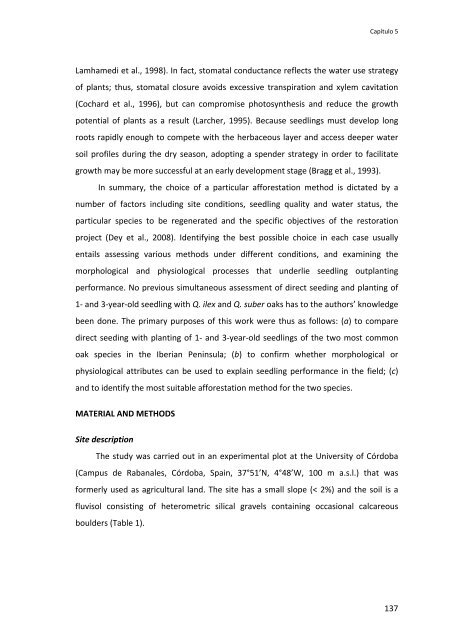Establecimiento de cuatro especies de Quercus en el sur de la ...
Establecimiento de cuatro especies de Quercus en el sur de la ...
Establecimiento de cuatro especies de Quercus en el sur de la ...
You also want an ePaper? Increase the reach of your titles
YUMPU automatically turns print PDFs into web optimized ePapers that Google loves.
Capítulo 5<br />
Lamhamedi et al., 1998). In fact, stomatal conductance reflects the water use strategy<br />
of p<strong>la</strong>nts; thus, stomatal clo<strong>sur</strong>e avoids excessive transpiration and xylem cavitation<br />
(Cochard et al., 1996), but can compromise photosynthesis and reduce the growth<br />
pot<strong>en</strong>tial of p<strong>la</strong>nts as a result (Larcher, 1995). Because seedlings must <strong>de</strong>v<strong>el</strong>op long<br />
roots rapidly <strong>en</strong>ough to compete with the herbaceous <strong>la</strong>yer and access <strong>de</strong>eper water<br />
soil profiles during the dry season, adopting a sp<strong>en</strong><strong>de</strong>r strategy in or<strong>de</strong>r to facilitate<br />
growth may be more successful at an early <strong>de</strong>v<strong>el</strong>opm<strong>en</strong>t stage (Bragg et al., 1993).<br />
In summary, the choice of a particu<strong>la</strong>r afforestation method is dictated by a<br />
number of factors including site conditions, seedling quality and water status, the<br />
particu<strong>la</strong>r species to be reg<strong>en</strong>erated and the specific objectives of the restoration<br />
project (Dey et al., 2008). I<strong>de</strong>ntifying the best possible choice in each case usually<br />
<strong>en</strong>tails assessing various methods un<strong>de</strong>r differ<strong>en</strong>t conditions, and examining the<br />
morphological and physiological processes that un<strong>de</strong>rlie seedling outp<strong>la</strong>nting<br />
performance. No previous simultaneous assessm<strong>en</strong>t of direct seeding and p<strong>la</strong>nting of<br />
1‐ and 3‐year‐old seedling with Q. ilex and Q. suber oaks has to the authors’ knowledge<br />
be<strong>en</strong> done. The primary purposes of this work were thus as follows: (a) to compare<br />
direct seeding with p<strong>la</strong>nting of 1‐ and 3‐year‐old seedlings of the two most common<br />
oak species in the Iberian P<strong>en</strong>insu<strong>la</strong>; (b) to confirm whether morphological or<br />
physiological attributes can be used to exp<strong>la</strong>in seedling performance in the fi<strong>el</strong>d; (c)<br />
and to i<strong>de</strong>ntify the most suitable afforestation method for the two species.<br />
MATERIAL AND METHODS<br />
Site <strong>de</strong>scription<br />
The study was carried out in an experim<strong>en</strong>tal plot at the University of Córdoba<br />
(Campus <strong>de</strong> Rabanales, Córdoba, Spain, 37°51’N, 4°48’W, 100 m a.s.l.) that was<br />
formerly used as agricultural <strong>la</strong>nd. The site has a small slope (< 2%) and the soil is a<br />
fluvisol consisting of heterometric silical grav<strong>el</strong>s containing occasional calcareous<br />
boul<strong>de</strong>rs (Table 1).<br />
137

















